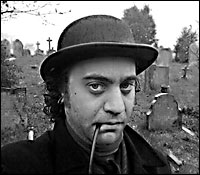 I had a dream the other night, the cast of which consisted in equal parts exclusively of people from Veronica Mars, and The OC.
I had a dream the other night, the cast of which consisted in equal parts exclusively of people from Veronica Mars, and The OC.N
 ot quite sure what that means, but there you are.
ot quite sure what that means, but there you are.I'm odd. That's what it means.
I mentioned a while ago that I like art, and have a particular interest in art crimes. (I'm too lazy to go back and link up the post - trust me, I said that.)
Anyway, the reason I find art crimes fascinating has to do with Provenance. This is the process of establishing the authenticity of a particular work of art, along with its own unique ownership trail. It's interesting, because an art thief not only has to come up with a plan to steal the work of art, but he also has to come up with a way to justify his possession of it when he tries to sell it.
Some art theft is "contract" work, where a private person pays someone to steal a particular desired piece of art to be placed in his personal and private collection. A person who contracts for this service pays dearly, and his only motivation is to HAVE the art, rather than to PROFIT from its eventual sale.
Anyway, I was thinking about all this a day or two ago, and then I heard an NPR story about "Funerary Violinists". How do these two things connect, you may ask...
I had never heard of a genre called Funerary Violinists. Odd, I thought, as I had once considered a career in musicology. This is not to say that I know everything there is to know about everything, but I would have thought I might have heard of this somewhere before. But I hadn't, so I listened with interest.
 An old dude named Rohan Kriwaczek wrote a book called An Incomplete History of the Art of the Funerary Violin. He claimed that funerary violin is a previously unknown musical genre that was virtually extinguished by the mid-19th century in the Great Funerary Purges, said to be ordered by the Vatican.
An old dude named Rohan Kriwaczek wrote a book called An Incomplete History of the Art of the Funerary Violin. He claimed that funerary violin is a previously unknown musical genre that was virtually extinguished by the mid-19th century in the Great Funerary Purges, said to be ordered by the Vatican.But as first reported in The New York Times, violin dealers, string-instrument publications and other experts say there is no evidence of the funerary violin genre, forgotten or otherwise.
The author claimed to belong to a secret guild of Funerary Violinists, and claimed it as the oldest continuing guild in the world. He was establishing provenance for this entire genre of music, claiming it was still flourishing, while being forgotten at the same time.
Despite the questions of authenticity, the book's U.S. publisher, Overlook Press, still plans to release the book, which includes pictures of legendary funerary violin composers like Hieronymous Gratchenfleiss, musical scores and information on the Guild of Funerary Violinists.
Peter Mayer, the publisher of Overlook Press, bought the manuscript. Even though he had doubts about the authenticity of the material, he was hooked.
Turns out to have been a hoax, illustrating the fact, again, that to claim some object (in this case, a forgotten musical genre), is one thing, and its provenance can prove to be its undoing.
Author Kriwaczek issued a statement Thursday, in which he writes that to call his work a hoax is to misunderstand his intentions. He says he wanted to "expand the notion of musical composition to encompass the creation of an entire artistic genre, with its necessary accompanying history, mythology, philosophy, social function, etc."And he notes that as a funerary violinist himself, he has performed at more than 50 funerals throughout southeast England.
You can hear some HAUNTING violin work at the link I gave up there. As well as read an excerpt from the book, to be published. Incidentally, the book, yet to arrive on shelves, is categorized in the "music history" section of both Barnes and Noble, and Borders.And for an utterly FASCINATING read, check out the story of John Myatt and John Drewe here. I find this a MOST compelling story. The movie rights have been optioned, but I don't remember by whom.
No comments:
Post a Comment